
There’s plenty of understandable excitement about Labor’s Cheaper Home Batteries Program election pitch. What I’m not so excited about is subsidising a wave of suburban survival-of-the-fittest types to disconnect from a grid that urgently needs more storage.
The plan is set to include off-grid systems and that’s excellent for punters in truly remote areas, but making it economically viable for others to pull the plug on their existing mains power will lead to poor outcomes all round.
Backup Batteries With Mains Power
As I explained last week, going off-grid in the suburbs is an expensive, risky choice that means people no longer enjoy the additional security blanket of grid backup.
Hybrid systems can provide blackout protection for your whole house. Provided the demands aren’t too crazy, there’s some pretty reasonably priced hardware available now. However, they rely on the stiffness of the grid supply to meet peak loads, even if it’s just for a split second.
But without connection to mains power, the rule of thumb is you’ll need FOUR times more solar and battery to make it work. It’s a waste of your money and everyone’s resources because that capacity will sit idle for a lot of its life.
You can become independent, with minimal bills for a handful of kilowatt-hours every quarter, that’s not in question.
But what we must prioritise is getting the whole system, and everyone connected to it, through overcast winter days. There will likely be gas burnt on still winter nights, but batteries will minimise it and their opportunity to gouge us… as usual.
Funding Batteries That Don’t Support The System
The electricity grid is a great and wonderful thing, like Medicare, roads, the sewer system; it’s a real first-world asset that we should be proud to be part of, and it should be publicly owned.
Sadly, some people don’t want to share their energy and they’ll spend irrational sums of money to stick it up everybody else. Some like to think that they’re rugged individuals, but we really can’t afford to publicly subsidise customers who want to go “off grid” in the suburbs.
We Must Not Underestimate Consumer Scorn
Sticking it to the man has been a driving force in causing people to spend irrational sums of money on solar power. I remember installing a 3kW system for $35,000! A 44c feed in tariff made it worth while but the main motivation was ETSA had been privatised, power prices nearly doubled, and this was “sticking it up their arse”.
As the grid has been soaked with solar, feed-in tariffs have fallen basically to zero. Some screech about a sun tax, but in reality, these charges for export are put into bundled retail deals that consumers never actually see.
There’s generation distribution, regulatory burden and dozens of other costs. You can explain it the six ways from Sunday, but people have a general principle objection to seeing their solar energy go onto the grid for greedy retailers to sell elsewhere at a markup.
Getting yourself an EV to kill your petrol bill and soak up more solar is ideal, but there will be times you’ll need the grid to do some faster charging.
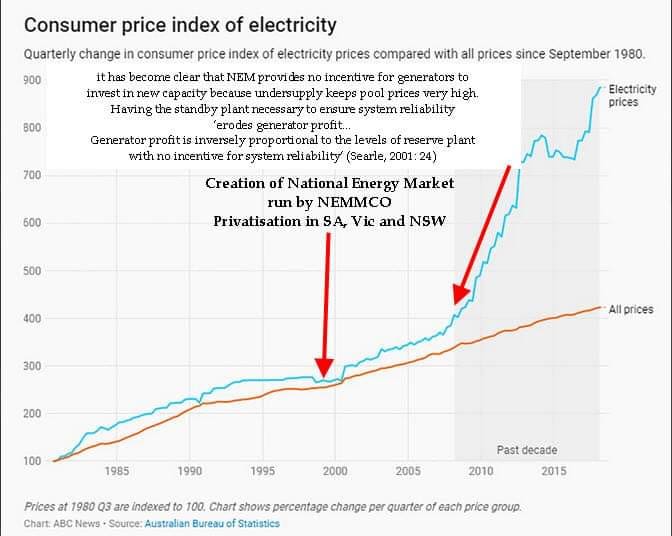
The design of the market is broken so it’s understandable people are irate
Lower Loads = Lower Bills
The systems we build to meet peak demand are expensive – take South Australia as an example. It’s only on a handful of hours, during a handful of stinking hot summer afternoons, that the electricity network is running full steam. On average, the grid is only utilised at about 40% of its potential capacity.
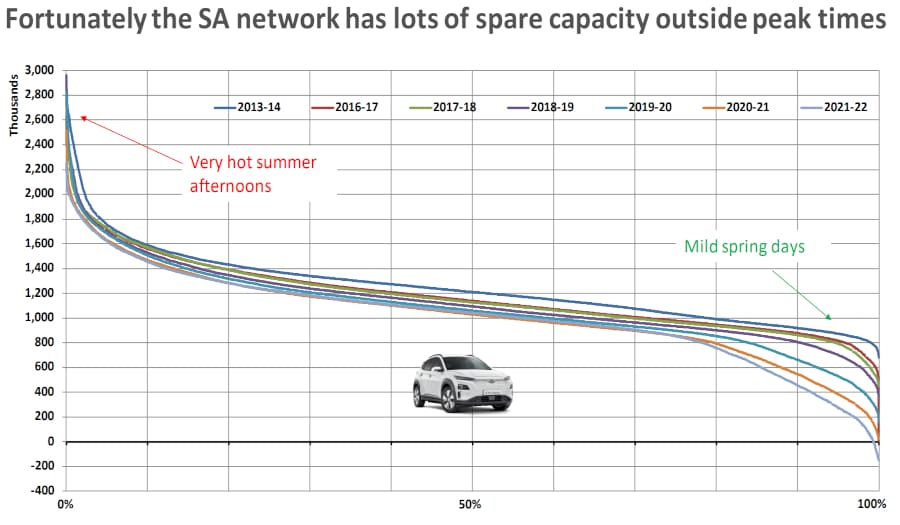
On the left we see 0% extra capacity available to meet total demand. To the right we see that every year there are more days with more spare capacity in the grid, to the point we’ve met all local demand. ie Negative 200MW is exported to Victoria.
By introducing energy at the bottom end of the system, where the rubber hits the road, we don’t need as many big generation hubs, nor do we need the spokes of heavy-duty transmission and distribution hardware to keep the wheels turning.
This is where everybody saves money,1 and the real bonus is that it’s more reliable and more efficient.
We have solar to meet our daytime demands and most people are up and about when it’s sunny, but we have to concentrate our efforts on meeting demand in the early morning and late evening, with batteries a big part of doing that – but they will only be useful to the broader grid if they’re actually connected to it.
Virtual Power Plants Mean Energy Everywhere
One step in the right direction is that the Cheaper Home Batteries Program is conditional on your hardware being VPP-ready. So with an internet connection and the right retail deal, you’ll be able to trade energy in and out of your battery.
Instead of paying fixed rates through an old mechanical meter, the future can see you charging your battery on a windy night when the market price is low.
Then, as the national toaster fleet fires up before dawn, we won’t be stoking up coal-fired boilers, you’ll either sell energy from your battery, or use it yourself in your own kettle.
As the day wears on, the sun rises, and prices go down. You can either use your own solar to run appliances, heat water, charge your car, or condition your air.
Or you’re roofless, you could buy cheap energy for these tasks, including recharging your battery.
Towards sundown, rates naturally rise and once again your battery comes into play, insulating you from peak prices while you cook tea.
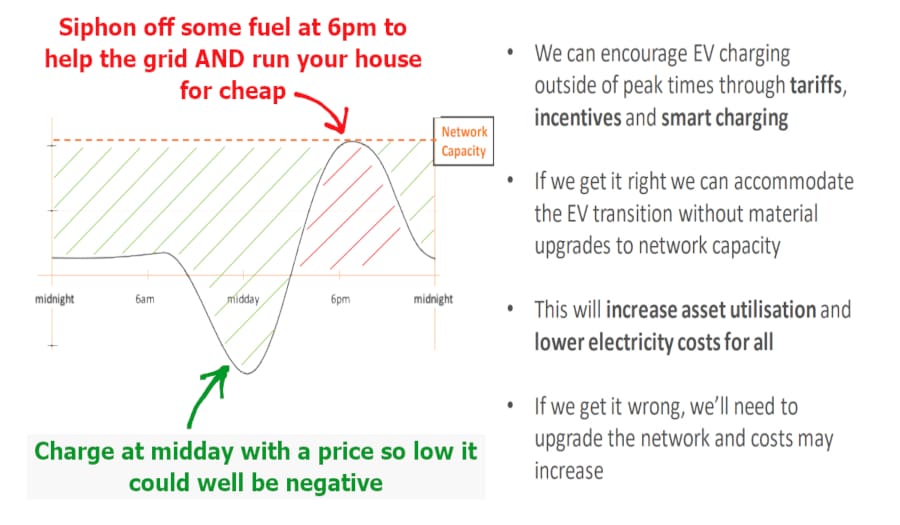
Provided we get daytime charging right, EVs are likely to be a boon for the grid, just like home batteries.
Backing Off-Grid Can Make Sense In Remote Areas
For our country cousins, it was cross subsidies from publicly owned assets that brought rural electrification schemes to life, but in a user pays network it can cost $40,000 to plant a pole and transformer to bring you mains power, so it can be economically feasible to install a remote area system, even in downtown Caloote, and there’s no reason why the scheme shouldn’t cover these sorts of cases.
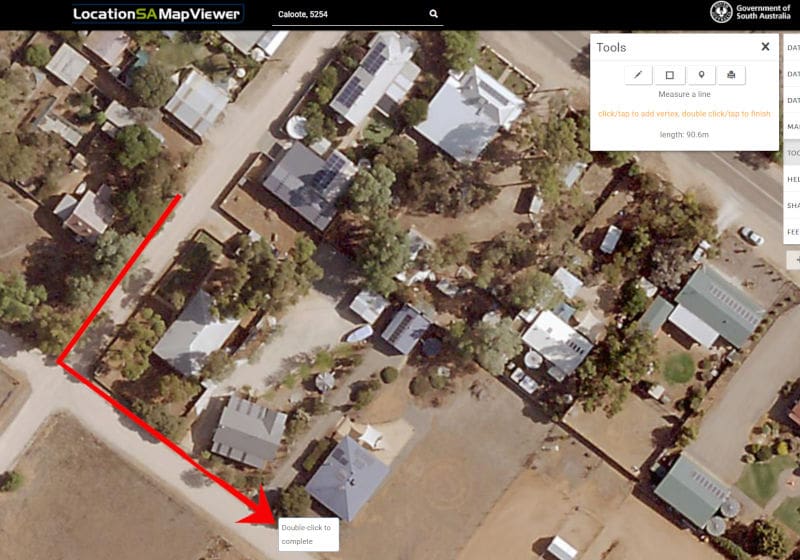
No transformer needed, but two stobie poles and just 90 metres of overhead wire made “off grid” economical for this holiday house
The Cheaper Home Batteries Program is designed to get people off fossil fuels, just like the RET and SHCP before it, because without solar and batteries, people in remote areas are burning diesel.
If we’re being honest, in a long overcast week of winter, they still rely on a backup generator, but it’s not impractical to run for 95% of the time on clean, quiet solar.

This brand new 3 cylinder diesel generator needed tuning to actually make it start consistently for the off grid system I installed. I can still smell this image.
Nobody Likes Generators
As a specialist remote area electrician, the main purpose of a generator is to make my phone ring. They don’t start reliably, they won’t hold frequency, the voltage is all over the place; but you still need one.
The only remote area customers who didn’t have generator complaints were the ones ringing up about flat batteries, because they were too tight to buy a generator and they’d cooked their battery warranty because of it.
But if you “go off grid” in the suburbs, your neighbours won’t wear a generator wailing through the early hours of a winter’s morning, and neither should you want to shower everyone in PM2.5 particles from the exhaust.
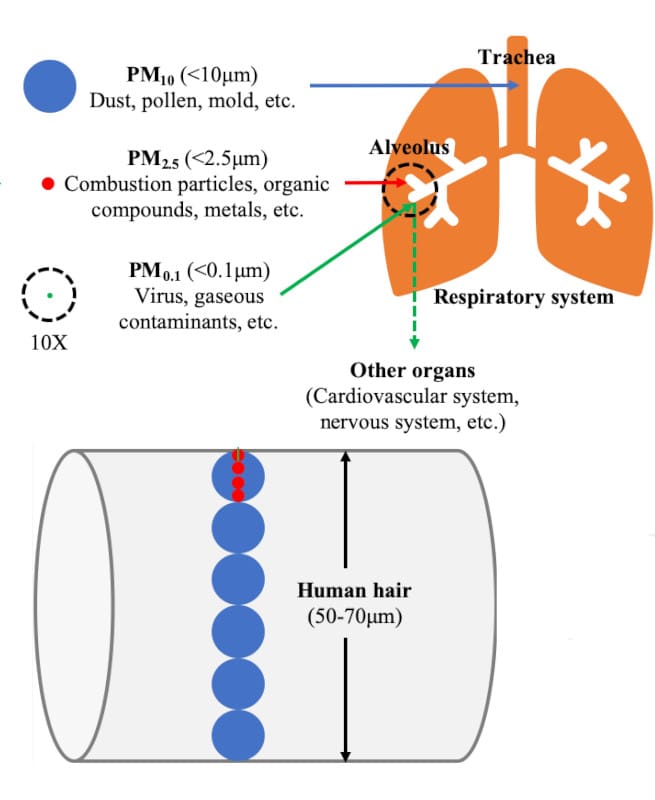
Particles one twenty-fifth the diameter of your hair can get right into your bloodstream. Image credit: frontiers – creative commons
It Wouldn’t Be The First Time
The law of unintended consequences can be a funny old thing. Government programmes with the best intentions can occasionally lead to really perverse outcomes.
We can cite the old Solar Homes and Communities Programme (SHCP) as an example. Years ago, John Howard’s government wanted to double its solar subsidy.
The industry called for SHCP eligibility to be increased from one kilowatt to two. This would leverage more private capital to install larger systems for better yield and less coal burning.
The government instead decided to double the subsidy from $4 to $8 per watt. The upshot was that cheap solar became free and the scheme was soon infested with blowflies.
It wasn’t a total disaster. There were lots more systems installed, lots more people trained, plus far greater volume was introduced to the market, which further increased competition and lowered prices.
The perverse part was that high subsidies created fly-by-night installers, piling on rubbish equipment that didn’t last.
Listening To Industry
It is perhaps a little bit unfair to single out the SHCP programme, simply because nobody on Earth saw what was coming.
The price of solar fell like a stone.
If you’re in the industry for any length of time, you’ll realise why they call it the Solar Coaster. Changes in exchange rate, network rules or clumsily enacted legislation can see business wax and wane like the natural disasters we’re trying to avert.
Thankfully, government on all levels appears to be interested and actively listening to what the industry has to say now.
Engagements with the federal and some state governments on how this battery scheme should operate if Labor wins the election have been quite promising.
Going It Alone Isn’t Sensible, It’s Selfish
Phone ducts bring you fast internet,2 water mains mean you can wash, sewer pipes prevent diseases spreading, but everyone has to contribute because if the neighbours are crapping in their yard, it’s a threat to your health too.
Like the roads themselves, public infrastructure running down your street is expensive, but it means people can live in the density that makes modern amenities work.
So if you want to disconnect from the wires on your street, I’ll suggest you’re not entitled to drive on it either.
The local shops near my place don’t have enough roof space to run the takeaway shop cookers, supermarket fridges or barber’s towel warmers, but the solar in our neighbourhood can keep them going.
We must work together, which means we must be connected.
For more about the pros and cons of off-grid systems, take a look at our explainer. For more detail on what Labor’s battery incentive covers, take a look at our dedicated page.

 RSS - Posts
RSS - Posts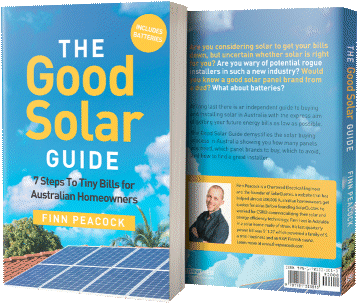


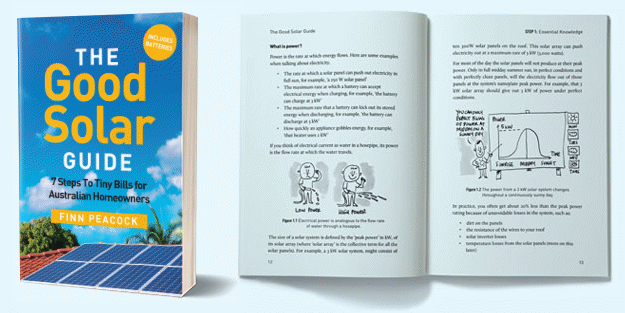
That’s going to fire up the Robinson Crusoes! A big hear hear to your analysis, I’m currently loading up my battery with free grid electricity, for use later. The new targeted retail and wholesale models make the grid a fantastic resource.
And grid power is increasingly just somebody else’s solar or wind, by not exporting back to the grid people are drying up the cheap or free grid power for others, including themselves.
Hi Nick,
This is precisely the point.
Victoria has done an abysmal job of both subsidising solar and then rendering the investment useless.
They’ve made such a hash of the “backstop” deployment… many installers and customers are just setting zero export because compliance is too hard to manage.
Hard 5kW export limits need to be removed because in winter we need as much as we can get when everyone is scratching for yield.
I would love to be able to send 5kw back when I have excess. AusNet has limited me to 1kw, so when my battery is full the system is throttled back.
I spent more than I needed for a hybrid system so when the grid goes down I can still cook and keep essentials running. I also sized it for self sufficiency in winter. I don’t think i would like someone helping themselves to my battery but they would be welcome to excess solar.
Financially it doesn’t make sense but it feels good if I leave an extra light on that I’m not burning brown coal.
Mark, that would be frustrating for sure.
As more and more grid is switched to renewables, solar should eventually be opened up to more and more solar feed in.
Most likely all states will adopt the SA flexible exports model.
This is a minimum 1.5kwh through to 10kwh export per phase, and from my now 17 months with solar, this has rarely been curtailed at all.
SAPN has a policy that benefits home solar over solar farms and other renewables, and over industrial / commercial rooftop, they get curtailed first, at least for now.
Summer days see us send up to low 9kwh or so to the grid, up to 80kwh a day over our tickover 450wh home use . . . albeit at the pitiful 4c FIT.
That will change.
It will be curtailed gradually as more and more renewables get put onto the grid, trials going on with that now here.
That’s why a battery is just about needed now and into the future to enable more self consumption outside solar soak, even for those that can self consume a lot of their production.
People have a choice to go off grid where ever they live and regardless of whether they have a grid connection available or not. This article is completely manipulative and is suggestive that people who want to live independent of the grid are doing the wrong thing by their community. A very obvious and persuasive tactic from the new owners of Solar Quotes, being Origin Energy! Poor form guys!
Hi Simon,
Thanks for missing the point.
I’ll try not to take the smear personally but I wrote the article because I don’t want to see anyone left behind. Origin has nothing to do with it.
For years solar has been a kind of middle class welfare, where those who can afford it get subsidised while the poors simply have to pay more and more.
Offering support for a new industry has been necessary and using that to leverage private investment is a great outcome.
However, using that generous support to then take yourself off grid isn’t.
It might minimise your impact but it doesn’t help the broader network.
Your argument reminds me of the numpties who protest they don’t have kids and thus shouldn’t have to pay tax for public education.
I’m happy to pay tax because I don’t want to live in a society full of libitarian imbeciles.
And I encourage people to pay for a grid connection because keeping the lights on is a public good.
Paying for a grid connection is a public good because it keeps the lights on. Whose lights? There seems to be some (citycentric?) assumptions there.
My wife and I own a home we pay a fee for water supply, sewage system, garbage collection, roads weather we use them or not because they are available to the community. They are supplied by Public Utilities.
The same should go for electrical power supplies but these have been sold off to private enterprise who have to make a profit. Blame the stupid short sighted polititions! But stay connected for the public good just make sure you keep enough power for your needs.
.
FYI It is only the SA government that is stopping the owners of the grid charging for supply regardless if you are connected or not.
People with solar (including me) mostly received substantial public subsidy to install it. And money well spent, as a nation. I think it also isn’t a subsidy designed for personal hoarding or gain, we have some responsibility to also put back into the grid. The cheap and free power I get from the grid at certain times every day now comes at least in part from the exports of other members of the public, and they in turn access what i export when it’s sunnier where I live and less so where they are.
I think you are correct here. It is all about the “social contract”.
I agree that going off grid with subsidised equipment in a populated location with good infrastructure probably breaks the contract.
Going off grid in a remote location with very expensive transmission lines may under some circumstances be a good thing in saving those expenses for the community. This is actually what is being done in remote communities in WA.
I am taking a punt here, but I think transmission network or “the grid” is the most expensive component. It certainly was for the customer access network for Telstra aka the NBN saga.
Hi Peter,
Network businesses have had the rules changes so they can supply far flung settlements with properly designed off grid systems.
They’ve found it cheaper than maintaining the long skinny network connections, especially when weather demolished parts than needed prompt reinstatement.
There’s no issue with that kind of pragmatism.
Thanks Peter. I see people here and elsewhere complain of a network charge of $1 or more per day, to access the grid. We spend more on milk or takeaway coffees than we do on this vital social infrastructure.
Nick it’s a conundrum with people spending upwards or $20k to get solar and battery, a point where they can virtually eliminate their bills with a small FIT to cover supply charges and not be a drain on the grid, it fact giving a fair amount of excess to the grid particularly winter / shoulder months.
But then I feel it’s very fair to have a small charge of that $1 or so to contribute to grid cost, the supply charge is not really all for that, most costs over generation costs are built into the tariffs.
I do see some folk paying up to high $1, $1.80 – $1.90 supply charge in comments online.
Supply charges, solar soak penalties, curtailment, and demand charges are all ways one can squeeze more from consumers if retailers can put a case forward and get approval.
We just need to be aware that every time rules are change, goal posts moved, solar / battery investment can look that little less attractive to those considering it, so it’s a fine line to walk when these decisions are made.
Apart from my personal motivation of sticking it to the man for my own solar and battery setup, I do get your point that a government subsided battery should be utilised for the greater good rather than personal advantage. (Which I agree with in principal, but I am always leary of politicians bearing gifts!).
However it would sit a lot better with me if I knew the recipient of the power I might want to / be able to export from my subsided battery, only paid a few cents more than what I got paid for it. IE the real costs of moving the power 100m up the road.
If there are middle men in the transaction blatantly profiteering, it is no longer a process for the greater good is it?
Agree 100%. The distributors have been ripping us off. If I can get the numbers to stack up I am off the grid with a petrol generator for back-up.
That was my immediate thoughts too Simon.
Absolutely putting my solar and battery in was all about “sticking it up their arse” To many years of getting ripped off for it to be for any other reason.
But i still have my grid connection, and realise i will need it for quite a while a yet.
Yes I weep tears of blood when I have to pay for a kw or two off the mongrels after 3 days of heavy cloud cover…
But I still dream that one day technology improvements may let me go that last step and get rid of the grid connection fee.!
Charging a daily connection fee is just asking people to go off-grid. It also provides diminishing incentive to reduce power wastage.
To Energex: a simpler flat rate would be smarter.
I really don’t consider many households have ‘irrational sums of money to stick it up everybody else’ and going it alone off grid style.
Things are still slow in the economy.
What will be bad for the whole market is if people get screwed over well enough by authorities and retailers that they just say bugger it, I’m not sending excess feed to the grid.
Getting bent over by the powers that be is a real danger.
Increasing supply charges, decreasing to virtually nil FITs, and probable that the solar soak penalty (sun tax) coming in will be increased in years to come.
If things get to the stage where people feel the goal posts have been moved too far, they will react.
Catch Power or battery settings to stop exports, moving to an Amber or other such wholesale type scheme, and worse . . . removing too many of the advantages of solar / batteries will see people saying it’s a scam (as seen on social media now), many that would have taken it up eventually, won’t any longer.
Easy fixed just pay a high fit say in-between 4 and 7 pm and most wouldn’t go off grid !!
Hi Peter,
There’s some elegance to an idea so simple as that. Might need some adjustment to the times but it’s a good concept to my mind.
Peter, yes a simpler variety of a VPP plan, but more attractive for most I feel.
I see various info here and there online that some states in NEM might be offering varying ‘sun tax’ options, as well as variable FITs.
If so, that will certainly encourage those with considerable PV / battery investment to contribute to the grid, even if the underlying personal aim is to ‘stick it to the man’ and be bill neutral (or in credit).
Thanks Anthony and les appreciated !!
I get $0.15 per kw between 5pm and 7pm. $1 credit if I have a zero hero day, which is drawing zero from grid between 5pm and 7pm.
I’d say a VPP that does what you ask exists. I paid 100% for my battery no subsidies unfortunately. Guess I paid the early adopter tax.
Anyway Google GloBird Zerohero. I don’t work there just a customer using it. Not too bad, sure I wish it paid more, but I’m on grid. Not paying much for the privilege, typically selling 20% of my battery and getting about $30 per month back in my bank account. Using free power between 11am and 2pm to charge 2 EVs. No fuel or power bill.
I would have loved a $4k discount on my battery. I’m helping the grid and myself without the discount it makes sense to me.
That 1st chart looks very familiar. 😉
Yes, I’m that guy. Not happy being a ‘victim’ of ETSA’s sale and little Johnny gave me $8k towards my first kW of solar. $20k all up back around 2000.
Followed by another 1.5kW in 2008 for about the same price with RECs reducing that by another $8k from memory. Thankfully the 44c and retailer FiTs have recouped my capital outlay for solar over the past 25 years.
Now as the SA PFiT won’t let me connect a battery to the grid, our own demand is mostly met by off-grid solar and batteries, only staying attached to export all of our solar during solar hours. Solar HWS helps.
If I am alive in July 2028, it will need to be financially advantageous for us to remain on grid.
People might have more sympathy supporting the grid if they weren’t feeling like they were being taken for a ride, when people read about the gas peakers gaming the system for profits and the privatised retailers and generators all extracting their pound of flesh from consumers you can’t blame consumers for wanting to be in control of their energy Independance.
I felt myself getting agitated reading the long introduction of this article wondering why a Solar business was attacking its customer base. When it finally got to the point, I found myself agreeing to the primary point: Solar and Battery has the potential to change the nation for the better, provided those who are fortunate enough to be installing batteries remain connected to the grid via Virtual Power Plants. I completely agree with this, even though many of us will look at the wholesale Daily Supply Charge (currently $1.88 in NSW where I am) and feel that it is extreme, when a Solar System has potential to allow a home to be fully off grid. Many will ask, why am I bothering to pay a Daily Supply Charge. To those folks I say:
1. It allows you to fully participate in the active trading of your excess stored power and achieve maximum price for your clean energy sales during peak demand periods (Summer Hot Days and Winter Cold Days, and Black Outs).
2. You have benefited for decades*/2
Gawd Marty, $1.88 a day supply charge is up there.
It takes a lot of FIT to cover that, especially as they get to the low 4c level.
We pay a very high series of tariffs for power here in SA, much of it to cover transmission costs, but supply charge is generally around low $1 with the larger players, smaller ‘competition’ (term used very loosely !) charge lower tariffs but higher supply charges.
I pay $1.02 inc gst daily supply with AGL, but think this is one place where the goal posts will be moved eventually, once retailers lose too much income from people with solar / batteries decreases.
Even though regulators are supposed to approve those rises, I’m sure retailers can get around it in some way / influence.
Those that can’t put solar on for either renting or financial reasons, will be left with even higher bills.
Not sure how this can be avoided.
The grid has to remain competitive if they want people to remain connected.
It’s a for-profit industry run for the benefit of shareholders, not people. If the electricity supply industry are constantly jacking up the costs to consumers, then they’ll reap what they sow.
Unfortunately grid service costs are going through the roof, none of it is the consumer’s fault and so consumers will decide whether or not it represents good value to remain connected.
VPPs are a nice idea in theory but frankly In real life they suck dog’s balls. All weighted heavily in favour of the VPP operator where the consumer carries all the capex risk of a VPP cycling your battery, for bugger all return.
We have water tanks to supplement town water supply (it’s our primary supply), waste water treatment is on us, no town service for that, roads are paid for by our taxes and rates. Poles and wires are however are a for profit business, so no, they are not the same as our roads and water supply.
I agree, most VPP plans are pretty poor right now.
If wanting to do your part for the grid and hopefully others that aren’t in a position to have PV / battery benefits, I think with a battery there will be much more value in using various ‘sun tax’ options for plans, if and when these are known in each state, as well as varying FITs that some are hinting at too.
Eg.
“Sun Tax in NSW
The Sun Tax is likely to be applied to customers in NSW from July 1 2025. Electricity distributors including Ausgrid and Essential Energy, have explained how the Sun Tax will work:
Customers charged 1.2c / kWh for exports between 10am – 3pm
Customers rewarded 2.3c / kWh for exports between 4pm – 9pm
Export free threshold (first 6.8kwh) to apply between 10am – 3pm”
I’m not sure if these are including the usual FIT one might be on, expect so, but of course these are dropping fast anyway.
Of NEM states, QLD, Vic, and Tas have said no to the proposals, at this stage, and so it should, stifles uptake.
I think calling it a “reward” for exports between 4PM and 9PM is (being polite) a mischaracterisation. Yes we would be “paid” 2.3c / kWh but this represents a significant loss for anyone doing it. the amortised cost per kWh from a consumer battery is much higher than that.
Phone ducts bring you fast internet? If you live in the right areas, sure. For everywhere else it’s slow or no internet, hence why Musk’s Starlink is a popular alternative to NBN. If slow or no internet is sufficient, NBN suffices.
Living without town water is a challenge, but some do manage it, mostly.
As for sewer pipes, there’s an increasing number of homes going their own way with that too e.g. town water but home sewage treatment. If you need an explanation, try talking to a plumber.
As for offgrid in the suburbs, it’s actually a really easy argument to make. With the push to go majority solar and wind, what difference does it make to rely on grid solar or own roof solar? Only if you rely on centralised power – nuclear, coal, hydro etc, is a grid necessary.
Financially there’s 3 factors – cost of power, cost of connection, and FiT revenue. Once connection costs exceed power costs, and FiTs no longer cover the cost, the argument to switch snowballs. Are we there yet? No?
After the government helps people go off grid. It won’t be popular, but it will come to pass that you will pay for a grid connection if there is one near you, regardless if you are connected or not. The only way to go off grid will be not to live near the grid. The Hong Kong power company have tried to put this in the contract every year since they brought SAPower. It will happen.
For VPPs to be attractive, there needs to be rules in place to protect people’s hardware. I don’t want my energy provider pushing my batteries to the limit with deep charge and discharge cycles and killing them in a few years. I also don’t want them taking so much that there’s none left when I need it. At the end of the day consumers are the ones forking or the lions share of the unit cost, that should be respected by energy providers, but I’m not sure the trust is there after all the price gouging we’re seeing on the market.
This. Lots of people don’t understand batteries. Like cars, they will last a lot longer with loving care. The government builds and maintains roads. Consumers build and maintain their cars. We are happy to pay registration and taxes because we hold government responsible for poor roads. We are also happy that government will spend dollars to give access to roads in remote parts of the state’s. If VPPs are to work, then we will want the same kind of regulation for the battery use as we do on vehicle use. We don’t want yobbos from far away hooning around in our expensive Mercedes.
What a wonderful article…. It had me scratching my head for a couple of minutes wondering who had written/ cobbled together stuff, where it was found, and why.
The thing that caught my attention most was trying to work out what the graph missing a Y axis legend was supposed to convey.
The whole history of the government interaction with the solar industry is about benefits to individuals who chose to take a punt/ invest. Tell me what benefit your neighbour having a subsidised solar array brings to you…. sod all.
If an energy supplier wishes me to supply a battery to help power the grid…they have to make it worth my while…. commercial incentive.
I’m not in the business of giving whichever mob is my energy provider a big bonus by selling them back battery power for sod all… and neither should the government be.
If the government chooses to setup regional or suburban batteries to help the grid then they should do so, and sell the service to providers.
Offgrid? sure
Don’t get mad people, get even. Stay connected to the grid and trade energy when it’s profitable for YOU. Only sign up to a VPP that factors in your battery LCOS and solar LCOE (and TOTAL grid import cost) before sucking off your battery.
You’ll find yourself eating Duck (Curve). Charging up off peak and off solar and peak shaving the gas gougers out of the picture. Good for you. Good for the grid. Not good for the gas & coal gougers.
Grid pricing should also enable cheaper pricing for consuming locally produced energy. This would be good for the grid too, but not the greedy gougers. Why don’t we have this? Like to hear your thoughts on this one Andrew … seriously!
Hi Darrel,
I find it interesting that the Qld government has instructed Ergon to pay a 13.5c/kWh feed in tariff under what they call an “avoided cost” model.
I’m curious to know if that’s the because they avoid burning coal, avoid transmission losses, avoid costly infrastructure upgrades… or a combination of all factors?
Interesting indeed, but what I would like to see is those renters & stratas getting the local PV energy closer to the cost of production and local-only distribution. It could be done with smart meters on the buy-side and the obligatory smart meters already on the sell side …
Contrary to how it may appear, I’m interested in win-win here, not just maximising my own investment.
Hi Darell,
LocalVolts can already give us peer to peer trading but we need regulation and or removal of the profit motive to curtail the network charges still.
That’s interesting Anthony, the QCA Draft is still advising a reduction to 8.69c/Kwh. Is there more recent info from Ergon/Energex or the Govt you can point me to?
I want the batteries to have cheaper electricity and save money, if I buy an electric car it’s a bonus. I forked out 13k for my solar and my bills are $600-1100 every 3 months and looks to go higher. If i save my excess with batteries 10-20kw then I might be able to get some positive equity from my panels.
Sonny, this is for a home ?
They’re high bills for what must be around 10-15kw of PV.
Are you not able to self consume much, or do you have shading issues / other possible system problems ?
We send around 75% avg through the year to the grid, how does that compare for you ?
I agree, a battery is a no brainer now, has been getting more obvious for perhaps a year or two.
We will certainly wipe our bills when we make that move, and still provide the grid with a decent bit of help too.
I don’t use any grid power. Through careful management I cover my own home use easily, even with only a 5.5kW system. But nearly all of my solar export (way more energy than I use) only just covers my connection cost.
Its becoming increasingly difficult to justify being paid a pittance for what “the man” takes for practically nothing and then basically rips off my neighbours with.
I don’t really get why I am supposed to feel selfish when I’m not the one profiting!
your graph of the price index of electricity compared to the other living costs show well over 4 times the increase of electricity to the other costs, (without the grid being over loaded or batteries available). Clearly adding batteries will not make a difference either, as providing our own home solar has benefited the few, while the price overall has just gone higher not lower. People need to stop dreaming of what should hypothetically happen and look at what really is happening (look at the graph). The only way that the suppliers of power or distribution will lower their exorbitant charges (and instead seek to increase efficiency) is if a lot more people defect from the grid. Giving our hay to feed their horses when it suits them will never encourage them to trade in the horse for a steam train!
Hi Tim,
You make an interesting point however I would expand on the train analogy.
Large gentailers have already progressed to steam engines.
However, in the digital age they’d desperately like to get rid of them…
Like Alinta who blew up Northern Power Station in Pt Augusta (when the Governement refused to buy it back for one dollar) and AGL who closed Lidell because it pre-dated colour TV & wasn’t reliable.
When Uber run a massive taxi business without owning a single car, Airbnb run a huge accommodation business without owning a single bed…
Electricity businesses would love to broker energy without owning any steam engines.
Keating floated idea but the NEM was organised by Howard. Then SA, Vic & the bulk of NSW privatisation was done by the LNP, which hasn’t served us well avoiding to the ACCC.
I think there’s a case for nationalising it again, before the system collapses under the weight of grid defections hopefully.
The big issue in my opinion is the poorly justified and constantly increasing fixed supply charges, which you have no control over via your usage. Ie currently paying ~$1500 – 2000a year total with a 15kw solar and $1.36/day or~$500/yr, of that is fixed. From my calculations if I got 20kwh of batteries installed I’d have almost 0 power usage (6 or 7days a year), but would still be paying 25-30% of my current bill.
That sets the stage pretty easily for the “screw you I’m not giving you more money” mindsets towards being network connected, especially given the lack of good (or any) explanation of the breakdown in supply charges.
Without these things being shared it’s very easy to make assumptions about network operators and gold plated networks for profit.
It does not help when you look at the profits of retail and network operators. Ausnet where I live takes half of my bill and has an operating margin of 30%, and is pretty slack about spending money to improve reliability. So 15% of the bill is just distributor profit. The retailer itself takes 25% of my bill. Their cut has doubled in 5 years, but the service is much the same.
Hi Liam,
The market is broken due in no small part to the design (instigated by Keating but actually set up by John Howard)
And of course privatisations, the bulk of which were done by Liberal state governments.
Even the ACCC now says that privatisation of essential services like electricity are not serving Australian people well.
This is dated but it helps explain…
https://m.youtube.com/watch?v=NqfBXaWuu-o
Many people I know pay more than 3 times that every year for takeaway coffee. I think we lose perspective, in my town we have the same argument over council rates in general. When I looked at the analysis, overwhelmingly people were paying far more for takeaway food, dining out and recreational travel than they were to support their own public infrastructure.
One thing in all this that bothers me a bit is the lack of local grid redesign and investment that could revolutionise our local area power systems. Why isn’t the government subsidy going towards local battery storage at every local substation in the country? Surely we would be better served by having larger professionally maintained grid batteries at local sites sucking all that excess solar into a larger battery for local consumption during the evening cooking and morning toaster blitz. That way all the people in the blocks of flats and townhouses could benefit from the solar investments up in the surrounding suburbs. We should be subsidised to fully populate our roof space with panels feeding local batteries hubs lowering the cost of power for all. As with all things transporting energy long distances is expensive so why not use the valuable resource of local roof space better?
Hi John,
While I fear a little about the reliability & quality of domestic batteries, there’s at least 4 compelling benefits.
1) Subsidies leverage private investment.
This means there’s self interest in…
2) maintaining a reliable system.
And more importantly there’s self interest in
3) energy efficiency
Plus there’s resilience offered by having energy behind the meter which isn’t reliant on the network.
Local power pole or substation batteries don’t have the scale that large utility projects have but they still cost a bomb because they are of course expected to meet commercial reliability & quality standards.
They do have the ability to smooth local power supply though.
I think there’s a case for all of them
Hi all, what worries me everything seems to be full steam ahead but at times not much thought is given into what can eventuate as we have seen. Shonky workmanship, materials and installs which have had there fare share of media and dangers. Now getting to the point, about the batteries and how they are used and installed. Similar to the panels, the housing industry was never designed to have solar installs and like wise now the batteries. All these were after thoughts and additions. Heaven forbid should one bank install explode and take out a house wall, what would happen then? If we are so intent in saving money and been energy efficient we need to consider all safety aspects and start designing houses appropriately. Let’s not wait until a devastating event happens to then rectify the situation.
Hi Terry,
Battery fires aren’t actually very common.
Plumbing flammable & asphyxiating gas into your house is seen as perfectly normal though, even after entire houses are blown to smithereens stemming from a gas leak.
Surely being “VPP Ready” also forces you to remain connected, no? Otherwise you’re not “ready”? Might be worth double checking this.
This is a ridiculous beat up.
I would estimate about 1-5% are likely to go off grid, having not the slightest effect on the enormous improvement to grid stability by the other 95%.
Hi Michael
Agreed on the credibility of this… More batteries will NOT cause more grid congestion leading to a grid crash. More batteries can cause a reduction in grid congestion, but never an increase.
Given this is election time, my cynical mind questions if this is a strategy to try to harvest votes for the coalition… the brainless party of nuclear power, coal, global warming, and a plethora of other policies that damage the community while making the super rich tiny portion of the australian population… a bit richer.
I wonder if the author is wishing readers to vote for the coal party in preference to labor, in a pyrrhic strategy similar to Bob Brown’s greens vote against labor’s carbon pollution reduction scheme in 2009…. which caused immense damage to australian climate change efforts.
I believe that a green vote is better than a coalition vote, but I’ve never forgiven them for what I saw as a blatant act of sabotage in an attempt to maintain political relevance.
Hi Koj,
I wouldn’t like to see anyone vote against their best interest but sadly the bulk of the media seem unable to report anything detrimental to their owners.
We can only hope the Greens have learnt that perfection shouldn’t be the enemy of the good. Being pragmatic will get us all a lot further than being ideologically pure.
John Howard introduced the RET but Labor ramped it up to be something useful.
Sadly, the politics around getting any other sort of price on pollution has been so badly poisoned, we’ll need generational change to get rid of the smell coming from the suppository of all knowledge.
In better news there’s now more millennials and zoomers voting than boomers.
Bloody communist I can hear them yelling when in fact it is simple collectivistic mindset. In Denmark, where they are so far ahead that they have ‘district heating’ (70 degrees hot water running underground from municipality run power plants that burn rubbish instead of letting it rot on the tip) you have to pay thousands of dollars to disconnect. And that is for a system that cannot benefit from load sharing like batteries can do to a power grid. Simple. The prices goes down the more we are to pay for the shared costs. As long as it is not privatised and profit maximised. Subsidise behaviour that you want and tax behaviour that you don’t want.
The way I understood the announcement, the install has to be grid connected. Which makes sense for the reasons you have given.
On-grid kills feasibility (edge case?)
I already have solar, but also want to use stored low carbon energy at night instead of buying fossil fuel derived power. We are a small household on a flat tariff. I manage to do cooking during daylight, so our power bills only slightly exceed the connection service charge. If we install a battery without going offgrid, the payback period would far exceed the expected battery life.
You make some good points in your blog, but i think a few people going off-grid can still help the cause. It means they definitely won’t be adding to demand during 5-9pm, or contributing to grid instability at noon. So long as it’s not everyone. Do we really need more than 20% of house rooftops connected to the grid?
you’ve influenced me to not to go off-grid. However, I won’t be getting a home battery either (will look for other green opportunities).
Hi David,
As a modest user you’re all over it. Batteries suit people with larger nighttime loads but if we were all as efficient as you are the problems would be much more easily solved.
The take home message form me is to have as much solar as possible spread across all the roofs to get geographically dispersed generation.
Ausnet in Victoria wouldn’t let me have a bigger system than 10kw even though I had heaps of roofspace for more and limited to 5kw FIT !!?
Hi all, agree with OP that it would be best collectively for users with batteries to stay grid connected. I will definitely get a battery if it comes with a rebate and would stay connected. Mainly to be supportive of this future industry Interesting comments about various buybacks, and I hope I’m not going off topic but what about the coalition’s nuclear plan. ? Has solar quotes covered this elsewhere? It is reliant on the coalition being elected and then sticking with the plan into the 2030’s. But if so then wont all our buybacks will be subservient to the government funded nuclear power plants. I’m writing this a day ahead of the election so possibly a moot point. Raising this as mostly the comments are about buybacks.
Hi Martin,
We’ve certainly got some nuclear grade content on the blog… it’s easy to search for.